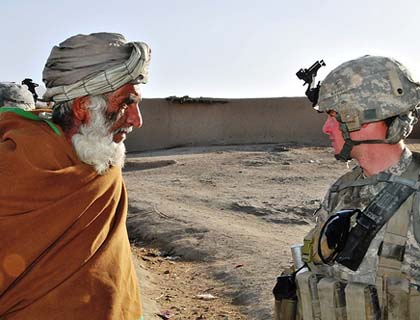The United States government andthe Pentagon, report edly, are considering a drastic expansion of the roles ofresponsibilities of the CIA in Afghanistan in the period after a major drawdownof U.S. and allied troops will be completed. The boosted role for the CIA, thatworks undercover, will involve assigning thousands of Special Forces personneland other elite anti-terror units to the agency. Given the nature of the workthe CIA does and its jurisdiction, these thousands of elite personnel will be giventhe covert status and will be deemed intelligence personnel as opposed tomilitary units. In this way, the U.S. will indeed be able to maintain asignificant military footprint in Afghanistan while officially it can claim ithas negligible to no military presence inside Afghanistan.
The high-profile CIAboost will enable the U.S. to pursue wide-ranging counter-terrorism campaignsunlike now when the U.S. and the international military coalition are engagedin a difficult and politically-expensive counter-insurgency campaign.
The U.S.is determined to continue with extending assistance to Afghan National SecurityForces in terms of training and equipping and modernizing the army and thepolice. Going by the pronouncements of Pentagon officials, this role, however,is set to take on much greater importance and urgency after the U.S. andcoalition forces will shift into support position and cease combat roles assoon as mid-2013.
The inconsistencies and contradictions in the pronouncementsand positions of American and NATO officials over the date of disengagement anddeparture from Afghanistan point towards the prevailing sense of confusion inthe Pentagon and the Obama administration regarding the Afghan war. This doesnot bode well for an Afghanistan that desperately needs long-term Americanmilitary commitment in addition to what its own national security forces manageto achieve.
The shift of military strategyfrom counter-insurgency (being a broad and tactically demanding undertaking) tocounter-terrorism (being much narrower and characterized by surgical operationsagainst active or perceived threats from the Taliban or al-Qaeda) in the periodahead, particularly after 2013, envisions a much greater reliance on thecapacities and capabilities of the Afghan National Security Forces.
For thesuccess of this plan, the U.S. military and the NATO envision a largelypacified Afghanistan particularly in its southern and eastern belt for theperiod ahead and this assumption does not seem to be able to stand a realitycheck as far as the ground realities in these areas are concerned. There stillare a diverse set of factors that complicate the situation. First of all, adeal with the Taliban, going by many indications, is proving to be impossible.
Therecent International Crisis Group's report is a timely eye-opener that throwslight on the helplessness of the situation. Even if the parties involved manageto secure a deal with this group, it will threaten to be very short-lived atbest and vulnerable to collapse as soon as the Afghan political and militarydynamics supporting it start to change. Next is the question of the governmentof Afghanistan in Kabul that continues to bleed credibility as, on the otherhand, the Taliban and other insurgent groups find it easier to be optimisticand confident of an advantageous position.
The Afghan National Security Forces,however strong, committed and resourceful, still would stand little chance ofkeeping the Taliban weakened and on the run as long as its masters in thegovernment continue to be divided and clueless as to how to confront theTaliban. In the post-2014 period, if the baseline would still be to preservethe government in Kabul and keep the Taliban at bay and limited to far-offdistricts and villages, then the very assumptions, on which the U.S.government, the Pentagon and the NATO base their post-2014 plans, are,therefore, shaky and susceptible to failure.
The strategic deal between thegovernment of Afghanistan and the United States is indeed in the interest ofAfghanistan. The divisions and skirmishes inside the government of Afghanistan havebeen partly responsible for the inordinate delay in finalization of the termsof the deal.
The Taliban and other insurgent groups such as the Hizb-I-Islamiare well cognizant of the happenings inside the government and have beenfurther emboldened watching the inaction and the sort of policy paralysis thathave plagued the government. Under current circumstances, if the government ofAfghanistan can overcome the serious differences of interest and put itsconsent on the deal, it would send a strong signal to the Taliban and otherinsurgent groups that Afghanistan's partnership with the U.S. is strong and thatthe government is not ready to compromise on some of the most fundamental principlesthat have come to prominence over the past one decade.
The future of Afghanistan, asrightly said, is uncertain. But what is certain is that the grounds forinstability, chaos and conflict continue to remain fertile no matter what theoutcome of the "talks about talks" will be. What consistently is being ignoredor downplayed is that the nature of the current conflict in Afghanistan is asmuch about a brewing civil war under the surface as it is about fighting apereceived international military occupation. This conflict has very powerfulethnic dimensions and it is not lost on the observers.
The way towards a settlementor even a semblance of it goes through a genuine national reconciliation amongthe ethnic stakeholders to this simmering civil war. Any peace plan thatignores this reality is unlikely to produce a lasting outcome. These realities,however, do not figure in the calculus of the international community and the governmentof Afghanistan.
Afghanistan's best chance ofsuccess at bringing lasting peace lies in undertaking a reform of the system ina fashion that governance can be delivered in consideration and recognition ofthe country's diversities.
As the Taliban and their mass following in theeastern and southern belts represent one dimension of Afghanistan's diversifiedpolity and society, so are other people and communities that deserve bettergovernance and more equal political rights. The guiding principle should be movingtowards a new paradigm wherein diversities can become a source of strength rather than a cause of conflicts.

